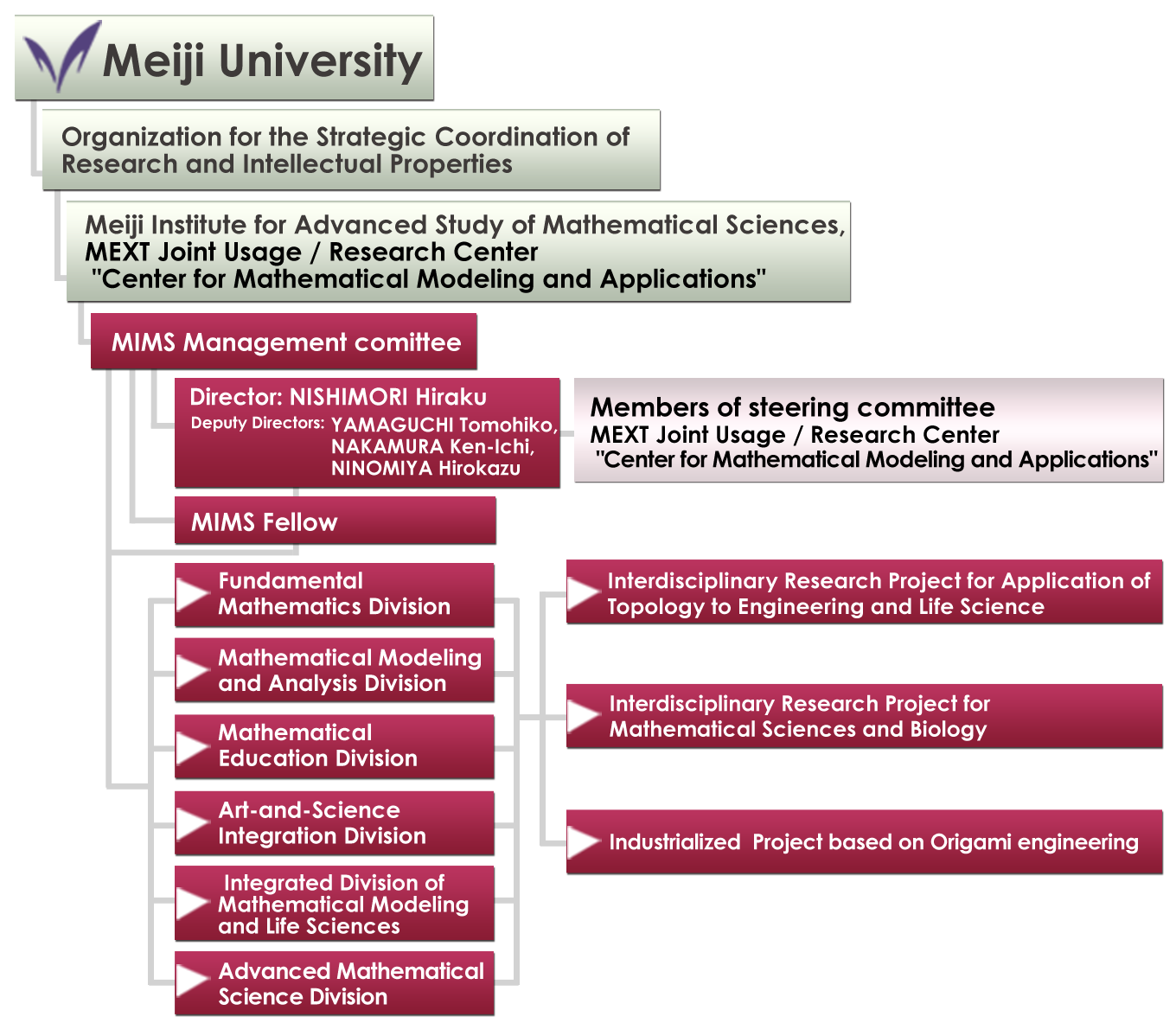Introduction
- Home
- Outline of MIMS
- Introduction / Collaborative Research Project
◆ Collaborative Research Project
Principle
Objective and Establishment
Meiji University established Meiji Institute for Advanced Study of Mathematical Sciences (MIMS) in 2007. MIMURA Masayasu is the Founder of MIMS.
The mission of MIMS is to develop mathematical sciences for the purpose of deepening our understanding of a wide variety of phenomena in society and nature. We are also focusing on returning our research results to society and on fostering young researchers through various programs. With these activities, we aim at forming a leading international research center.
MIMS Research divisions:
(1) Fundamental Mathematics Division
(2) Mathematical Modeling and Analysis Division
(3) Mathematical Education Division
(4) Art-and-Science Integration Division
(5) Integrated Division of Mathematical Modeling and Life Sciences
(6) Advanced Mathematical Science Division
Organization FY2024

FY2024 Collaborative Research Project
Interdisciplinary Research Project for Application of Topology to Engineering and Life Science
Purpose of the project:
By performing interdisciplinary research for topology, engineering, and life science, we promote collaborations among researchers in these areas from the point of view of mathematical sciences. Nowadays, topology has been applied for various research fields such as sensor networks and motion planning in engineering and analysis of complex geometric structures of proteins in life science etc. We aim to perform research among these areas beyond the traditional boundary of disciplines. We study fundamental theory which can be shared by researchers of various areas and also collaborate to develop the interface by means of the techniques in computing topology.
Summary of research:
Topology is a branch of mathematics which has been rapidly developed from the middle of the 20th century. We apply contemporary techniques in topology to engineering and life science. Especially, we study topological data analysis such as persistent homology theory in relation with various research areas including material science and life science. Our research will include applications of knot theory to genetic research, graph theory for networks, and application of the theory of configuration spaces to robotics. For the purpose of supporting research of various disciplines, we will develop computer software including the ones for VR and archive such digital information. Our activity will also cover the visualization in geometry and art. We perform research in collaboration with Kyushu University Institute of Mathematics for Industry, The University of Tokyo Virtual Reality Educational Research Center, Art Center the University of Tokyo.
Period of research project: Until March 2026 (the period of the collaborations)
Project leader: KOHNO Toshitake (Professor, School of Interdisciplinary Mathematical Sciences, Meiji University)
Interdisciplinary Research Project for Mathematical Sciences and Biology
Goal:
The international research network on Reaction-diffusion systems in Mathematics and Biomedicine (GDRI ReaDiNet) has been started from 2015 under the cooperation among six research institutions of MIMS and Department of
Mathematical Sciences of University of Tokyo (Japan), Paris-Sud University and
University of Nice Sofia Antipolis (France), Kaist (Korea), National Center for Theoretical Sciences (Taiwan).
Since 2020, due to the reorganization of the CNRS project, the name has been changed to the IRN-ReaDiNet project, and the activities have continued.
Outline of the Research:
Through Mathematical Sciences based on modeling and analysis, we focus on understanding of complex system arising in biomedicine and develop theoretical methods on analysis and numerical simulation under international cooperation with other research institutions.
Research Period: to December 2029 (which will be the final year of the IRN-ReaDiNet project)
Leader: MATANO Hiroshi (Distinguished Professor Emeritus, Organization for the Strategic Coordination of Research and Intellectual Properties, Meiji University)
Industrialized Project based on Origami engineering
Object:
It is aimed to solve problems for industrialization of origami structures by merging advanced origami geometry, computational science simulation and manufacturing science. Because we meager origami geometry and computational science, we promote joint research with researchers and engineers in the manufacturing field. We aim to find solutions to problems common to all origami structures for their industrialization by acting as a hub between various fields.
Research overview:
The research of origami engineering is entering its third period, which is expected to yield many fruitful results. The first period was filled with excitement about creating origami structures which are (1) light and rigid, or (2) has expansion and contraction functions. In the second period, efforts were focused on solving two issues that hindered origami engineering promotion. The first one was that maintaining stability after expansion or contraction was difficult and the other one was that it was difficult to find an inexpensive manufacturing method without losing the wonderful features of origami structure because the origami structure is generally more complicated than the general structure. It is shown that the origami group of MIMS is leading the way in this brilliant third period in SIAM(Society for Industrial and Applied Mathematics)newsletter.
Furthermore, we aim to contribute from the cultural aspect of origami engineering. A characteristic of Japanese culture is beautiful simplification such that (1) Creating beautiful hiragana based on kanji, (2) Beautiful origami with simplified shapes, (3) Tanka and haiku that simplify written expressions, (4) Fan of simplified expression through pictures. Among them, the fan looks different depending on the angle from which it is viewed so that many great painters such as Jyakutyu Ito and Hokusai Katsushika, etc. in Edo period attempted to simplify expression through painting with fan. However, because the face of fan is distorted, the perfect circle on 2-dimensional fan picture becomes ellipse on 3-dimensional fan. And so, it was difficult to compose with fan so that fan's pictorial simplification was not always sufficient. To solve this, we have developed a mathematical model that can reproduce "distortion of fan face" with high precision (Hagiwara, I., Yamazaki, K. and Abe, F., Fan, conversion device of fan picture, conversion method of fan picture and members of fan picture, Patent application No. 2020-149060,in Japanese). With this mathematical model, we have already developed a system where for example, if you look from the left, you can see images related to the above phrase and if you look from the right, you can see images related to the below phrase. Based on this mathematical model, we are aiming to create a new unique Japanese culture that handles Tanka simplified by text and fan of simplification through pictures (images) at the same time. At the same time, we will also promote second generation origami engineering with regard to related industrialization that treats not only sheet but also members such as fan and umbrella, etc. and has excellent characteristics that cannot be achieved with either one alone in contrast to conventional origami engineering that deals with sheets alone.
Furthermore, through joint researches, we aim to commercialize related structures to the following patents such as
- Hagiwara,I. and Nara,C., Container, Patent application No. 2017-201993,in Japanese,
- Hagiwara,I. and Nara,C.,Folding structure, Patent application No. 2015-245594,in Japanese,
- Hagiwara,I.and Zhao,X.,Crash energy absorption structure forming equipment ,crash energy absorption structure and crash energy absorption structure forming method, Patent application No. 2021-215790,in Japanese,
- Hagiwara,I.and Zhao,X., Forming method of spherical tank and spherical tank, Patent application No.2022-097813,in Japanese,
- Hagiwara, I. and Zhao, X., Core panel, core panel forming method and core forming device, Patent application No. 2022-177019, ,in Japanese
- Hagiwara ,I. and Zhao ,X., Shock absorber, Patent application No. 2023-037761, ,in Japanese
and - Hagiwara,I. and Sasaki,T., Hat, Patent application No. 2023-194075,in Japanese.
Installation period: Until the end of March in 2026 when the joint research ends.
Project leader: HAGIWARA Ichiro (Meiji University distinguished professor emeritus, Organization for the Strategic Coordination of Research and Intellectual Properties)




